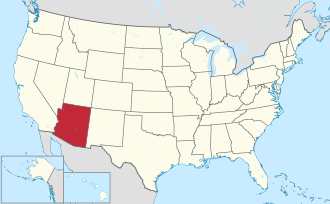Coconino County | |
|---|---|
 Old Coconino County Courthouse in Flagstaff | |
 Location within the U.S. state of Arizona | |
 Arizona's location within the U.S. | |
| Coordinates: 35°42′N111°30′W / 35.700°N 111.500°W | |
| Country | |
| State | |
| Founded | February 18, 1891 |
| Named after | Hopi designation for the Havasupai, Hualapai, and/or Yavapai tribes |
| Seat | Flagstaff |
| Largest city | Flagstaff |
| Area | |
• Total | 18,661 sq mi (48,330 km2) |
| • Land | 18,619 sq mi (48,220 km2) |
| • Water | 43 sq mi (110 km2) 0.2% |
| Population (2020) | |
• Total | 145,101 |
• Estimate (2024) | 145,161 |
| • Density | 7.7932/sq mi (3.0090/km2) |
| Time zone | UTC−7 (Mountain) |
| Congressional district | 2nd |
| Website | coconino |


Coconino County is a county in the North-Central part of the U.S. state of Arizona. Its population was 145,101 at the 2020 census. [1] The county seat is Flagstaff. [2] The county takes its name from Cohonino, [3] a name applied to the Havasupai people. It is the second-largest county by area in the contiguous United States, behind San Bernardino County, California. It has 18,661 sq mi (48,332 km2), or 16.4% of Arizona's total area, and is larger than the nine smallest states in the U.S.
Contents
- History
- Geography
- Adjacent counties
- Indian reservations
- National protected areas
- Demographics
- 2020 census
- 2010 census
- 2000 census
- Communities
- Cities
- Towns
- Census-designated places
- Other communities
- Ghost towns
- Indian reservations 2
- County population ranking
- Politics
- Economy
- Transportation
- Major highways
- Education
- See also
- References
- External links
Coconino County comprises the Flagstaff metropolitan statistical area, Grand Canyon National Park, the federally recognized Havasupai Nation, and parts of the federally recognized Navajo, Hualapai, and Hopi nations. As a result, its relatively large Native American population makes up nearly 30% of the county's total population; it is mostly Navajo, with smaller numbers of other tribes.
The county was the setting for George Herriman's early 20th-century Krazy Kat comic strip.




